The Science Behind Flashlight Colors: What Each Light Color Is Used For
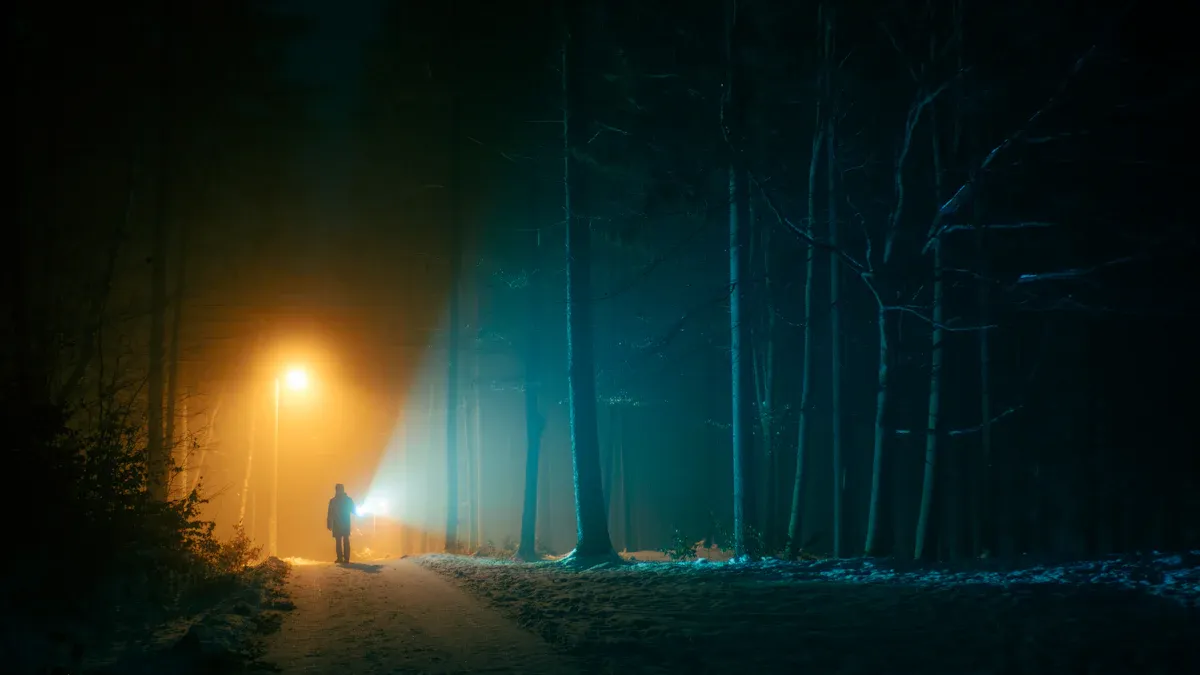
Different flashlight colors have special uses. Your eyes respond in different ways to each color and brightness. Science explains why some colors help you see better sometimes. If you know about flashlight color modes, you can pick the best flashlight for you. This helps you work better and feel more comfortable anywhere.
Key Takeaways
Flashlight colors have special uses. Red light helps you see at night and keeps bugs away. Blue light helps you find blood and stay safe.
Knowing about the light spectrum helps you pick a flashlight. Use red for nighttime. Use green for hunting or reading maps. Use amber when it is foggy.
White light is good for most jobs. It lets you see clearly and shows real colors. This makes it great for reading and working.
UV light shows things you cannot see easily. It helps you find stains and check security marks. You need to wear safety gear to protect your eyes.
Picking the right color mode helps you do better. Choose the flashlight color that fits your activity. This gives you better sight and keeps you safe.
Light and Color Basics
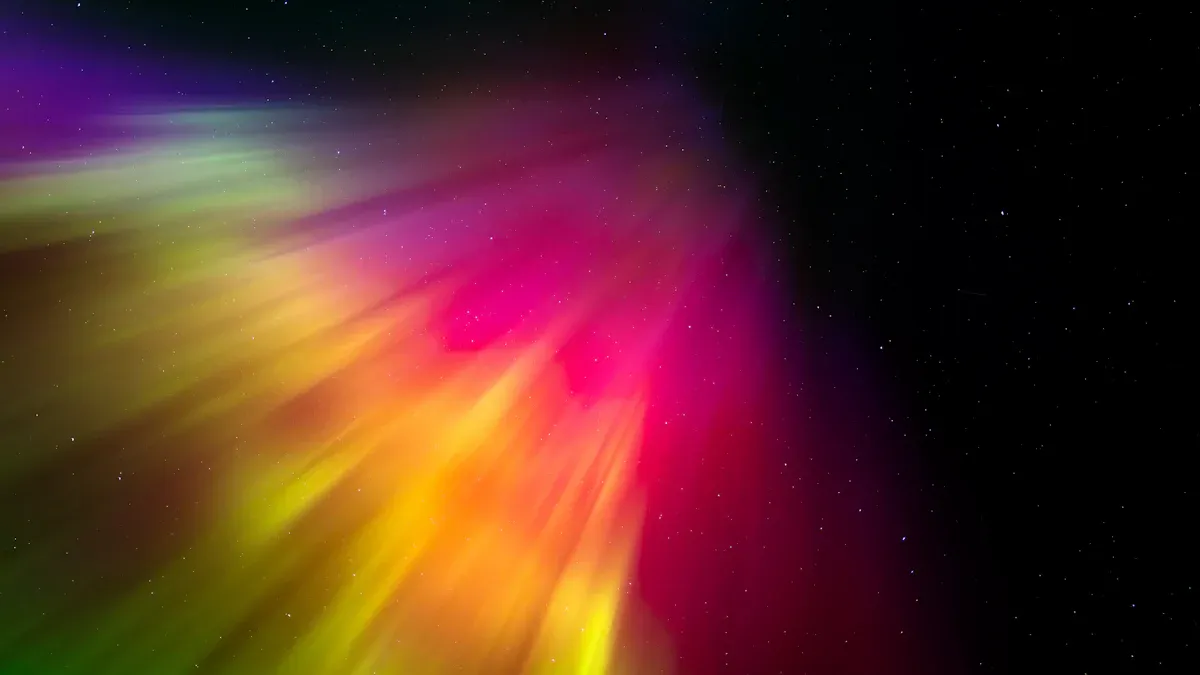
How Light Works
You can see things because light moves in waves. Each wave has its own length, called wavelength. The visible light spectrum has all the colors you see, from red to violet. When you use a flashlight, you mix colors by adding them together. This is called additive color mixing. The main colors of light are red, green, and blue. When you mix these, you get new colors like yellow, cyan, and magenta. If you mix all three main colors, you get white light. You see colored shadows when something blocks some light waves. This shows how mixing colors works in real life.
Light acts in different ways in different places.
Red and amber, which have longer wavelengths, go through fog, rain, and dust better than blue or violet.
Blue and violet, which have shorter wavelengths, scatter more and make it harder to see.
The way your flashlight beam is aimed and focused also changes how well it works in these conditions.
Knowing about the light spectrum helps you pick the right flashlight color. You use secondary colors for special jobs, like reading maps or tracking animals, because they work differently with the environment.
Human Vision
Your eyes use special cells called cones and rods to see light. Cones help you see colors. There are three types of cones. Each type sees a certain wavelength: blue cones at 430 nm, green cones at 535 nm, and red cones at 590 nm. This system lets you see many colors. Your eyes can adjust to different light levels because of how they work.
Different flashlight colors can change how awake you feel and how well you do things.
Blue light helps you pay attention and react faster. Red light makes you more alert and can help you do tasks better.
Light Color | Effect on Alertness | Performance Impact |
|---|---|---|
Red | Makes you more alert | Helps you do tasks better |
Blue | Helps you focus | Makes fewer mistakes |
You use main and mixed colors to see well in different situations. The science of mixing colors and colored shadows shows why you need different flashlight modes for each job.
Flashlight Color Modes
Why Color Modes Matter
Flashlights often have more than one color mode. Companies make these modes to help you do many jobs. You can change the color to get the light you need. This makes things easier and keeps you safe.
Most flashlights have several color choices. You will see these colors in many flashlights:
Red
Green
Blue
White
Yellow
UV
Other colors
Each color works best for certain tasks. White is good for lighting up a room. Red or green are better for special jobs. These colors help you see well, keep your night vision, or stop bugs from coming near.
Color modes let you control your light. You can pick the color that fits your activity. This helps when you are outside, working in emergencies, or reading maps at night. Colored shadows can show details that white light might hide.
The table below shows how each color mode is used and what it helps with:
Light Color | Common Uses | Advantages |
|---|---|---|
White light | Weapon lights, powerful flashlights, general illumination | Good for visibility but can impair night vision |
Blue light | Reading maps at night, investigations, search & rescue | Preserves night vision, highlights details, illuminates traces like blood |
Red light | Night-time activities, preserving night vision | Provides contrast, less impact on night vision |
Green light | Hunting, fishing | Soft light that does not attract insects, less disturbance to animals |
Yellow light | Retaining night vision while distinguishing colors | Similar benefits to white and red light |
Infrared light | Used with infrared viewers, often on weapons | Not visible to the naked eye, useful for stealth applications |
Ultraviolet light | Verifying authenticity of banknotes, illuminating fluorescent materials | Highlights invisible traces, popular in party settings |
Tip: Change the color mode to match your activity. Use red for night vision. Pick green for hunting. Try blue for tracking.
You get more from your flashlight when you know how each color works. Color modes help you see in fog, smoke, or dark places. You can use different colors to avoid scaring animals or bringing bugs. When you learn about primary and secondary colors, your flashlight becomes a better tool.
White Light
General Use
Most people use white light for many tasks. This color gives you bright and clear light. It helps you see details in any place. When you use a flashlight with white light, you see objects in their real colors. This makes it easier to work quickly and do things right.
White light helps you stay focused and get more done. In offices, using white light can help you work 20% faster. Artists and designers do 25% better with white light because it shows colors clearly. You need this when matching colors or spotting small changes. You can change the color temperature from warm to cool. This lets you set the mood or help your sleep.
Tip: Pick a flashlight that lets you change white light from warm to cool. This helps you feel good and stay focused.
White light is important for reading, working, and moving in the dark. It helps you make fewer mistakes and keeps you awake. Most flashlights use white light as the main mode because it works in many places.
White light does have some downsides. It may seem less fun than other colors. In some places, like rooms with colored walls, white light might not work best. Colored lights can make you feel calm or excited, but white light cannot do this. White light also does not show colored shadows as well as other modes.
Here is a table that compares white light and colored light modes:
Feature | White Light | Coloured Light Modes |
|---|---|---|
Productivity | High | Varies |
Colour Accuracy | Excellent | Limited |
Mood Effects | Neutral | Calming or stimulating |
Visibility | Clear | Depends on colour |
Use white light when you need to be accurate and alert. For special jobs, try other colors or modes to get the best results.
Red Light
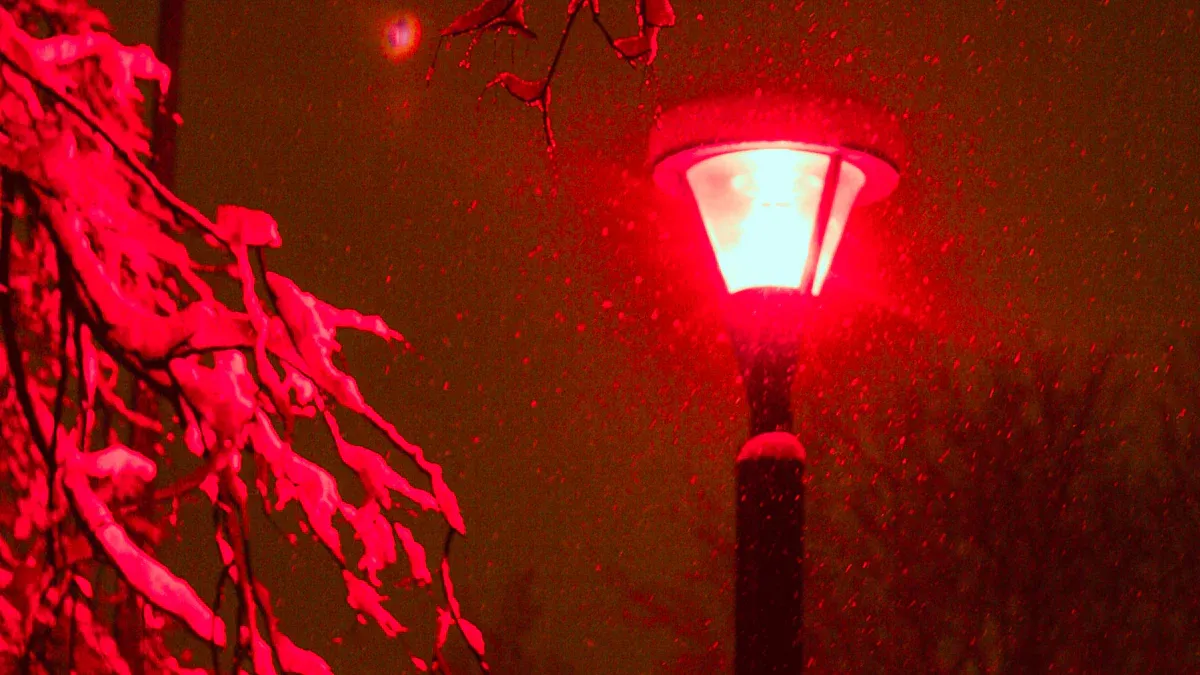
Night Vision
You need to keep your night vision safe in the dark. A red flashlight helps your eyes get used to low light. Red light does not make your pupils get smaller like white or blue light. You can look around and still see well in the dark. Many workers use red-filtered flashlights for this reason.
Red is a main color in the visible spectrum. It has a longer wavelength than most other colors. This means it spreads less and does not hurt your eyes. Scientists have checked how red light changes vision. The table below shows what they found:
Study Year | Findings | Details |
|---|---|---|
2012 | Red light therapy keeps mitochondria healthy | In a mammal test, red light therapy stopped eye cell death and kept the retina working. |
2018 | Big improvements in seeing clearly | A study with 33 patients over 5 years showed better vision and less swelling and bleeding, with no bad side effects. |
Red light helps your eyes stay healthy and lets you see better at night. Many flashlights have this mode for outdoor trips, looking at stars, and military jobs.
Insect Avoidance
Red light also helps you keep bugs away. Most insects cannot see red light well. If you use a red flashlight, bugs do not notice you as much. This makes camping and hiking easier.
Some people think red light is invisible to all animals, but that is not true. Here are some things people get wrong:
Rats can see red light, so it is not hidden from them.
Even weak red light can change how mice sleep.
Low red light at night can change animal hormones and body chemistry.
Use red light to keep your night vision and avoid bugs. This color mode is great for outdoor fun. Pick a flashlight with red mode for your next trip.
Green Light
Hunting
You often need a special color when you hunt at night. Many hunters choose green light because it helps you see animals without scaring them as much as white or blue. A green-filtered flashlight gives you a clear view of your surroundings. This color stands out in the dark, so you can spot movement and details easily.
Scientists have studied how green light affects animals and people. One study in Sci Transl Med found that green light can activate certain brain cells in mice. This effect may help you stay alert and focused during long hunts. However, not all animals react the same way to different colors. For example, deer show a strong reaction to green light, while they barely notice red. You can see this in the table below:
Color of Light | Deer Response | Notes |
|---|---|---|
Red | Minimal reaction | Deer perceive red light as gray brightness, causing little disturbance. |
Green | Strong reaction | Deer react more strongly to green light compared to red. |
Blue | Not mentioned | No specific information provided about blue light. |
If you want to avoid alerting deer, you may want to use red instead of green. Still, green remains a primary choice for many hunters because it helps you see tracks, blood, and terrain features better than other colours.
Map Reading
When you read a map in low light, you need a color that helps you see lines and symbols clearly. Green light works well for this job. Your eyes respond better to green than to most other colours. You can use less light and still see every detail on your map.
Green light enhances visibility in low-light conditions because your eyes are more sensitive to this color.
You can read maps with less light intensity than with red or white.
The military often uses green light to help soldiers keep their night vision.
A green flashlight lets you read maps without making your eyes tired. You can switch between tasks and keep your night vision strong. Many flashlights now include green as a standard mode for outdoor and tactical use.
Tip: Use green light for map reading and close-up tasks. You will see more details and keep your night vision longer.
Blue Light
Blood Tracking
Blue light helps you find blood that other colors miss. When you shine blue light on a surface, blood stands out. This happens because blood reacts with some chemicals. Luminol and fluorescein are two common methods in forensics. Luminol reacts with hemoglobin and glows bluish-green. Fluorescein works best with blue light and makes blood glow. You need darkness for these reactions to show up well.
Here is a table that shows how these methods work:
| Method | Wavelength Range (nm) | Reaction Type | Visibility Enhancement | |---|---|---| | Luminol | N/A | Chemiluminescence | Glows bluish-green | | Fluorescein | 420 - 485 | Fluorescence | Fluoresces under blue light |
Blue light works better than red or other colors for this. Fluorescein reacts with proteins and iron in hemoglobin. It works best between 460 and 480 nm. This makes blood much easier to see in investigations. If you want to track blood outside or at a crime scene, use a blue flashlight.
Tip: Use a blue flashlight in the dark to spot blood fast and easily.
Specialized Uses
Blue light is helpful in many other ways. Blue light therapy treats seasonal affective disorder. It also helps people with Parkinson's disease sleep better. Studies show blue light works as well as white light for these treatments. Blue light helps you see natural gas fires more clearly. NIST researchers found blue light helps in hot places. It makes fire imaging safer and easier.
Blue light also keeps roads safer. Many people think flashing blue lights slow cars down. They also make drivers pay more attention. Most people like blue lights at the start of work zones for safety.
83% say blue lights help slow cars.
87% feel more alert near flashing blue lights.
68% want blue lights at the start of work zones.
You can use blue light for therapy, safety, and finding things. Blue is a main color and has special uses that red and green do not. Flashlights with blue modes give you more choices for special jobs.
Amber Light
Fog and Smoke
You face tough conditions when you use a flashlight in fog or smoke. Amber light helps you see better in these situations. This color cuts through haze and dust more effectively than other colours. You notice that amber falls between red and yellow on the visible spectrum. It shares some traits with red, which is a primary colour, but offers unique benefits.
Amber light has a longer wavelength than blue or green. This means it scatters less in the air. You get a clearer view when you use amber in foggy or smoky areas. Many professionals choose amber flashlights for search and rescue, firefighting, and outdoor work. You avoid glare and reflections that white or blue light can cause.
Tip: Use amber light when you need to see through fog, smoke, or dust. You will spot hazards and obstacles more quickly.
You find that amber light preserves your night vision almost as well as red. It does not make your eyes tired. You can switch between tasks without losing focus. Amber also helps you distinguish objects and colours in low visibility. You see details that other colours might hide.
Here is a table that compares how different colours perform in fog and smoke:
Colour | Visibility in Fog | Eye Fatigue | Night Vision Preservation |
|---|---|---|---|
Amber | Excellent | Low | Good |
Red | Good | Very Low | Excellent |
White | Poor | High | Poor |
Blue | Poor | Medium | Poor |
You should pick an amber flashlight if you work in places with smoke or fog. You get better safety and performance. Amber light gives you an edge over other colours. You make fewer mistakes and keep your eyes comfortable.
Note: Amber light works well for signaling and emergency use. You attract attention without blinding others.
UV Light
Detection
You use UV light in flashlights for many kinds of detection. This color is special because it shows things you cannot see with red or other colors. When you shine UV light, you can find stains, marks, and features that regular light misses. This tool is important for crime scenes, checking documents, and safety checks.
UV light helps you find bloodstains, body fluids, and fingerprints. Dried blood looks dark brown or black under 365nm UV light. Body fluids like semen and saliva glow, so they are easy to spot. You can see fingerprints on many surfaces with a UV flashlight. You also use UV light to check documents for hidden security marks. UV light shows fibers and hair, which helps you collect small clues.
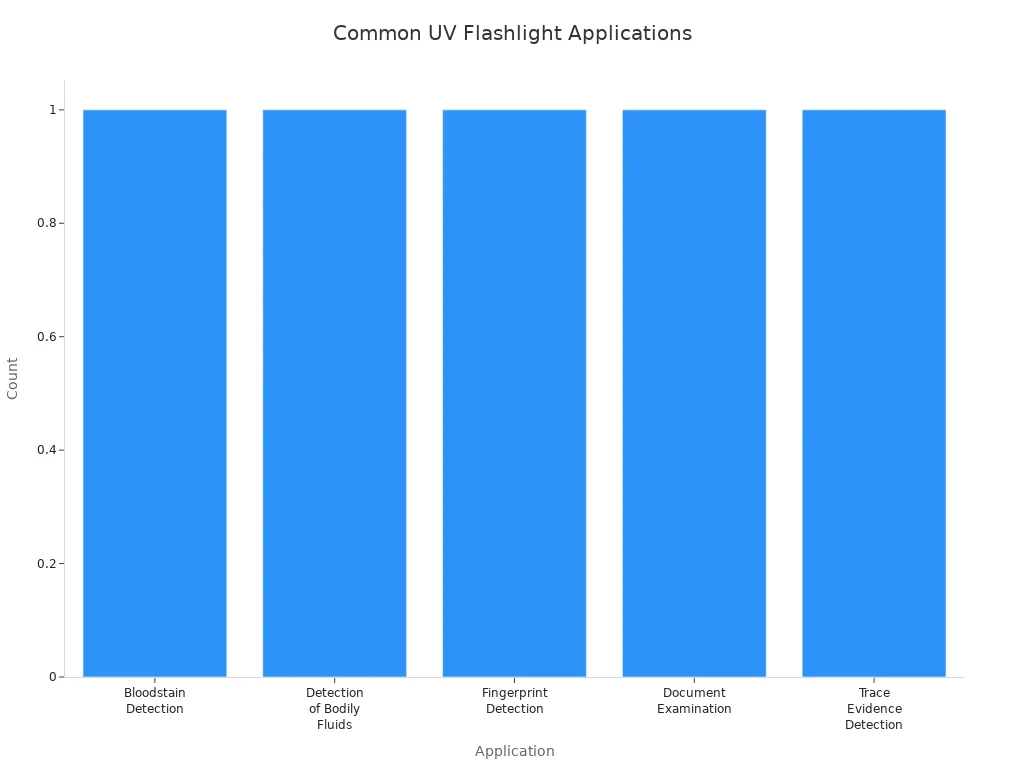
You see that UV light works best for finding clues in forensic science and police work. The table below lists common uses and what they help with:
Application | Benefit |
|---|---|
Bloodstain Detection | Shows dried blood at crime scenes |
Bodily Fluid Detection | Finds semen and saliva for investigations |
Fingerprint Detection | Shows hidden prints on surfaces |
Document Examination | Finds secret security features |
Trace Evidence | Spots fibers and hair |
You must follow safety rules when you use UV flashlights. Experts say you should wear a polycarbonate face shield with ANSI Z87.1-1989 UV certification. Regular glasses do not block UV rays. You need clothes that cover your skin. Always wear UV-certified goggles. If you feel pain or burns, get medical help right away.
Note: UV light can hurt your eyes and skin. You stay safe by wearing the right gear and following safety steps.
You use UV light for jobs that need careful checking. This color mode helps you more than other colors like red. You make your flashlight better by learning how UV detection works.
Choosing the Right Mode
Quick Comparison
You have lots of choices when picking a flashlight. Each color mode helps in different ways. You should match the color to your job and where you are. This helps you see well, stay safe, and work better.
You use red for night vision and to keep bugs away. Green is good for hunting and reading maps. Blue helps you find blood and small details. Amber works best in fog and smoke. UV light shows things you cannot see with other colors. White light is best for seeing everything clearly.
Tip: Pick the color mode that fits your needs. This helps you do your job well and keeps your eyes safe.
You can check how well each color works by looking at how you recognize and remember things. The table below shows how good you are at seeing and remembering under different lights:
Task Type | Condition | Recognition Accuracy (%) | p-value |
|---|---|---|---|
Object Recognition | Illuminated | 61.18 ± 0.97 | N/A |
Object Recognition | Flashlight | 63.89 ± 0.96 | N/A |
Memory for Targets | N/A | 82.04 ± 0.77 | N/A |
Memory for Distractors | N/A | 43.01 ± 0.99 | N/A |
VR Recognition (Targets) | Both Conditions | Equal Recognition | p = .971 |
VR Recognition (Distractors) | Flashlight | Significant Memory Boost | p = .001 |
Computer Screen Recognition | Flashlight | Barely Missed Significance | p = .050 |
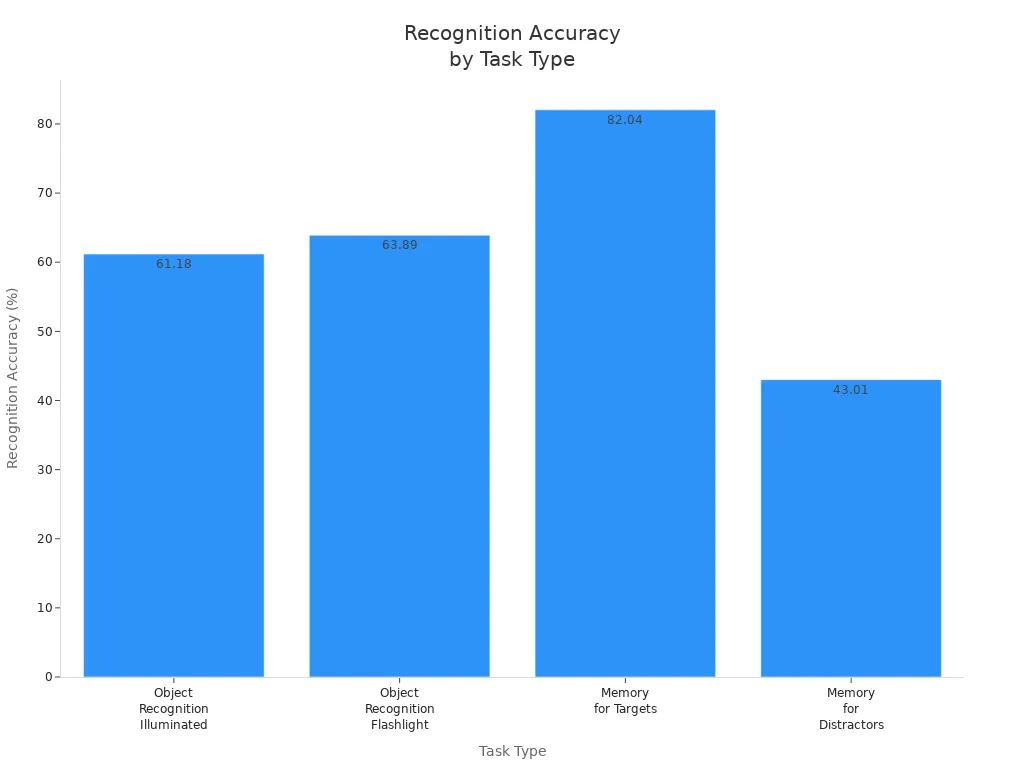
You should think about where you are and what you need to do. For quick jobs, use Turbo or High mode for the brightest light. For normal use, Medium or Low modes save battery and give enough light. SOS mode is for emergencies. Flash mode helps cars see you when you walk or bike at night. Strobe mode is good for self-defense or signaling when it is hard to see.
Here is a table to help you pick the best color mode:
Color Mode | Best Use Cases | Key Advantages |
|---|---|---|
White | General illumination, work, reading | High visibility, true color accuracy |
Red | Night vision, insect avoidance, astronomy | Preserves night vision, less bug attraction |
Green | Hunting, map reading, tactical tasks | Soft light, less animal disturbance |
Blue | Blood tracking, investigations, safety | Highlights details, preserves night vision |
Amber | Fog, smoke, signaling | Cuts through haze, low eye fatigue |
UV | Detection, forensics, document checks | Reveals hidden clues, trace evidence |
Use red for night and looking at stars.
Pick green for hunting and reading maps.
Switch to blue for tracking and safety.
Use amber in fog or smoke.
Choose UV for finding hidden things.
Note: You get the best results when you match the color mode to your job and where you are.
You make smarter choices when you know how each color works. You stay safer, feel better, and get more done by picking the right mode. Use this guide to help you choose the best flashlight for your needs.
You can see that each flashlight color has its own job. Red is good for keeping your night vision safe. It is also used for signaling and watching animals. Red helps you stay hidden and is great in emergencies. Stargazing and secret missions often use red light. You pick red to avoid scaring animals and to help your eyes in the dark. The table below shows what each color does best:
Color | Purpose |
|---|---|
White | Good for lighting up any place or for daily use. |
Red | Best for camping, saving night vision, and warning others. |
Green | Works well for hunting because animals do not mind it. |
Blue | Helps find blood trails and see in fog; hunters and police use it. |
UV | Checks if documents are real and finds body fluids. |
You should always pick the right color for what you are doing. Knowing how light and colors work helps you choose better. Try different color modes to get the best results every time.
FAQ
What flashlight color is best for camping?
You should use red or amber light for camping. These colors help you keep your night vision. They also attract fewer insects. White light works well for setting up tents or cooking.
Can colored flashlights harm your eyes?
Most colored flashlights are safe for your eyes. UV light can cause harm if you look at it directly. Always wear protective glasses when you use UV flashlights.
Why do hunters use green or red lights?
Hunters use green or red lights because animals see these colors less clearly. You can spot animals without scaring them. Green light also helps you see details in the dark.
Is UV light useful for everyday tasks?
You can use UV light to check for stains, pet messes, or fake money. UV light shows things you cannot see with normal light. Always use UV light with care.
See Also
The Ultimate Guide to Selecting Colorful Flashlights for Adventurers
Comparing Police Flashlights and Standard Ones: Which Wins?
Understanding Flashlight Lumens: Your Complete Brightness Resource
